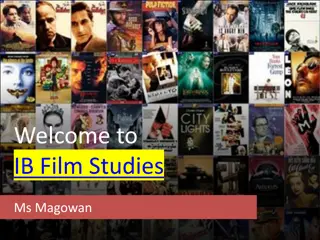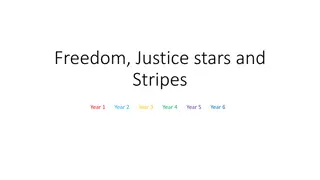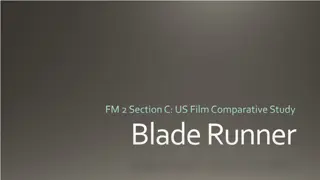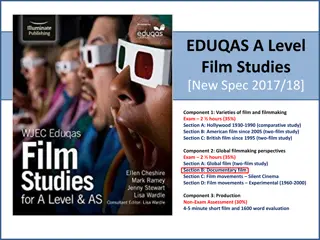Exploring the World of Film Noir: Shadows, Mystery, and Intrigue
Delve into the captivating realm of film noir with a journey through its origins, unique characteristics, and iconic movies. Uncover the influence of low budgets, gritty source materials, atmospheric lighting, and innovative camera work that defined this cinematic genre. Discover how European directors revolutionized Hollywood in the 1930s and 40s, shaping the dark and suspenseful narratives that continue to fascinate audiences today.
Download Presentation

Please find below an Image/Link to download the presentation.
The content on the website is provided AS IS for your information and personal use only. It may not be sold, licensed, or shared on other websites without obtaining consent from the author.If you encounter any issues during the download, it is possible that the publisher has removed the file from their server.
You are allowed to download the files provided on this website for personal or commercial use, subject to the condition that they are used lawfully. All files are the property of their respective owners.
The content on the website is provided AS IS for your information and personal use only. It may not be sold, licensed, or shared on other websites without obtaining consent from the author.
E N D
Presentation Transcript
Playing with Shadows an introduction to FILM NOIR FILM NOIR DARA HOGAN
Take a moment Take a moment to look at each film still in turn What do you see in each photo? What adjectives would you use to describe each photo? What mood do you feel each photo evokes? Compare the two film stills
Towards a Definition Film Noir Film Noir French critics used Film Noir to describe American Films of 1940 s/50 s Common attributes Theme Setting Lighting Camerawork Dialogue
Origins Low Budget B Movies Compete with TV Double Bill Newsreel Cartoons Serial B Movie Main Attraction Actors/Directors on way up (or down)
Low Budget No money for big stars, fancy costumes, elaborate sets, big stunts Had to rely on plot twists, clever dialogue, unusual lighting and camera work Less money meant less supervision Directors could experiment European directors brought new influences Why did European directors move to Hollywood in the 1930 s and 40 s?
Source Material Pulp Novels Hard Boiled Detective Novels Often trashy Sensationalist Sometimes accomplished writers acted as screenwriters Raymond Chandler
Lighting Typical Hollywood movies were very brightly lit Three Source Lighting Everything visible Happy, Happy, Happy Very Slow/Expensive
Lighting B Movies often shot at night Tight schedule/small crew Often set at night Dimly lit rooms Shadowed streets Suited subject matter Portrayed a dark world
Camera Work Re-used sets/costumes Attempt to make them look different Strange Angles Shot through blinds Grid over faces Rain on a window pane
Hero/Anti Hero Not traditional Good Guys Outsiders Private Eye/Ex Cop No Friends/Family Morally Questionable Brains and Brawn Do the right thing?
Dialogue Narrator/Voice over Slang Broads Bulls On the lam Double Entendre
Quotes Marlowe: You know what he'll do when he comes back? Beat my teeth out, then kick me in the stomach for mumbling Tom Regan: All in all not a bad guy - if looks, brains and personality don't count. Verna: You better hope they don't. Brendan Frye: Uh-huh. And he wants cash on the nail. He's a pot-skulled reef worm with more hop in his head than blood. Why pay for dirt you can't believe?
Setting Usually urban City seen as menacing and dangerous New York, Chicago, Los Angeles, Gotham Documentary style Bars, nightclubs, gyms, doss houses Alienation Corruption
Storylines Complicated Complicated Red Herrings Red Herrings Double Crossing Double Crossing
The Big Sleep (1946) Private detective Philip Marlowe is hired by a rich family. Before the complex case is over, he's seen murder, blackmail, and what might be love. Director: Howard Hawks Writer: William Faulkner Stars: Humphrey Bogart, Lauren Bacall and John Ridgely
Millers Crossing (1990) Tom Regan, an advisor to a Prohibition-era crime boss, tries to keep the peace between warring mobs but gets caught in divided loyalties. Director: Joel and Ethan Coen Writers: Joel and Ethan Coen Stars: Gabriel Byrne, Albert Finney and John Turturro
Brick (2005) A teenage loner pushes his way into the underworld of a high school crime ring to investigate the disappearance of his ex- girlfriend. Director: Rian Johnson Writer: Rian Johnson Stars:Joseph Gordon- Levitt, Lukas Haas and Emilie de Ravin
Suggested Reading Overview of Film Noir http://filmmakeriq.com/2010/08/ultimate-filmmakers-guide- to-film-noir/ The Big Sleep http://www.filmsite.org/bigs.html Miller s Crossing http://www.bfi.org.uk/filmtvinfo/publications/16+/pdf/moder nnoir.pdf Brick http://www.freshfilmfestival.net/images/studyguides/FFF_ Brick_Study_Guide_2008.pdf
IMAGES Google Images Advanced search, images listed as 'available to use, share or modify, even commercially'. Picture Credits: It's a Wonderful Life, 1946, Dir. Frank Capra, RKO Radio Pictures The Big Sleep, 1946, Dir. Howard Hawks, Warner Bros. Roman Holiday, 1953, Dir. William Wilder, Paramount Pictures Touch of Evil, 1958, Dir. Orson Welles, Universal Pictures The Man Who Wasn't There, 2001, Dir.Joel Coen, Working Title The Manchurian Candidate, 1962, Dir. John Frankheimer, United Artists The Maltese Falcon, 1962, Dir. John Huston, Paramount My Dream is Yours, 1949, Dir. Michael Curtis, Warner Bros. Detour, 1945, Dir. George Ulmer, Producers Releasing Corporation Double Indemnity, 1944, Dir. Billy Wilder, Paramount Pictures Miller's Crossing, 1990, Dir. Joel Coen, 20th Century Fox Brick, 2005, Dir. Rian Johnson, Focus Features























